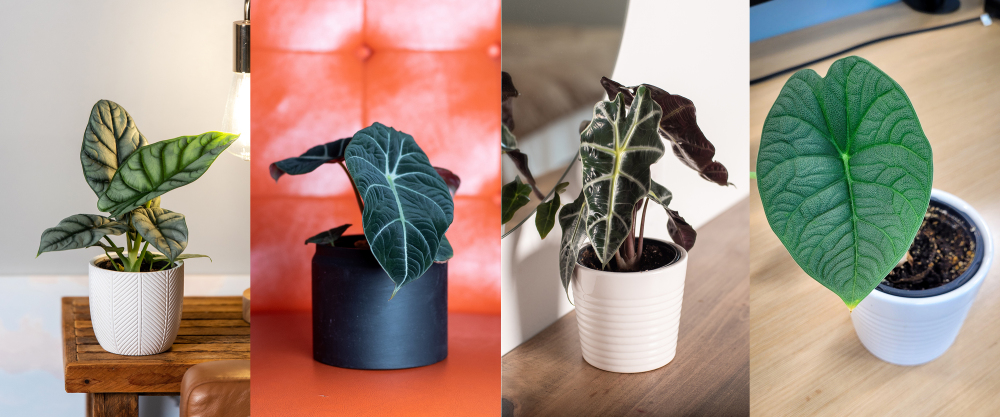
Alocasia Silver Dragon, Alocasia Black Velvet, Alocasia Elephants ear and Alocasia Melo are just a few of the many variations of Alocasia plants pictured above. With various looks and textures, Alocasia’s make a striking appearance whenever you see them.
Caring for an Alocasia requires giving it bright in-direct sunlight, regular watering and a humid environment is where they will do best. Due to their species being native to the sub-tropical temperatures of Asia and Eastern Australia, giving them care and an environment like their natural habitat is where they do best.
Alocasia plants can handle a range of light levels from low light to bright indirect light. The amount of light that it receives will determine how quickly it grows. If you want your Alocasia to continue to grow at a high growth rate, then be sure to give it bright in-direct sunlight throughout the day.
If you are in a low light environment your alocasia will survive but may not grow as quickly as other plants. Another key tip is to not place them in bright direct sunlight as their leaves can quickly burn or dry out with direct lighting.
Alocasia’s love being in loose, nutrient rich soil. Using a soil medium that can retain moisture but allow for optimal drainage will help ensure that your plant does not suffer from root rot. Most premix soils will do the job, however adding organic matter such as coco-coir, peat moss or shredded leaves will help keep this plant looking its best.
Water your alocasia when the top few inches of soil feel dry to the touch. Allowing its soil to partially dry out between watering's is ideal for this plant. During the colder months you can reduce its watering frequency if your plant is not actively growing.
It is best to keep its soil evenly moist but not over saturated. Keeping its soil too moist will lead to fungal, pest issues or root rot.
As a tropical southern plant, Alocasia’s prefer warmer temperatures. Keeping the temperature of the room above 15 °C (60 °F) will be the best for your plant. Avoid placing them near any hot or cold drafts such as an Air Conditioner, window.
Remember that if you live in a colder winter climate these plants can go dormant. So adjust your plant care based off how your plant is reacting.
Alocasia’s can benefit from regular fertilization when they are in their active growing season. Alocasia varieties that are known for large leaf growth can benefit from feedings. Adding a liquid organic fertilizer diluted to half strength or follow the directions on the bottle. It is best to fertilize your Calathea only during its growing season.
Most Alocasia Varieties can be propagated using Rhizome division. This is an easy task and will provide you with many more plants. Doing this in the spring during its growing season will provide the best results and lowest chance of putting your plant into shock.
1. Dig up your plant using a spade and choose a healthy root clump – ensuring that there are plenty of rhizomes to divide
2. Using a pair of clean pruners or knife, cut off a piece of the under-soil rhizome and pot them separately into a new moist potting mix.
3. Keeping your plant and pot warm and moist until its new growth appears is the best way to ensure successful propagation. You can place a bag over the plant to increase the heat and humidity around the plant. This can take up to a few weeks to fully happen so be patient!
Placing your Alocasia in bright indirect sunlight is where they do best. However, another pro tip would be to rotate your plant every so often so that all areas of the plant are receiving the light that it needs.
Alocasia’s are known to be root bound. So, there is not an urgent need to re-pot them. However, since Alocasia’s can be a fast-growing plant they can outgrow their current pots rather quickly if given the right conditions.
When you feel that it’s time to repot your Alocasia, choose a pot that is 1-2” larger than its current pot. When re potting be sure to carefully transfer the plant to reduce the risk of root damage.
Yellow leaves that are seen on your plant can be due to a variety of factors. Most commonly It can be due to watering. Either too much or too little water can lead to yellow leaves. As well as if they are receiving less than the desired amount of sunlight.
Brown leaves can be an indicator that your plant is receiving too much sunlight. Burnt ends or dried out leaves mean that you should move your plant somewhere that receives bright but in-direct light.